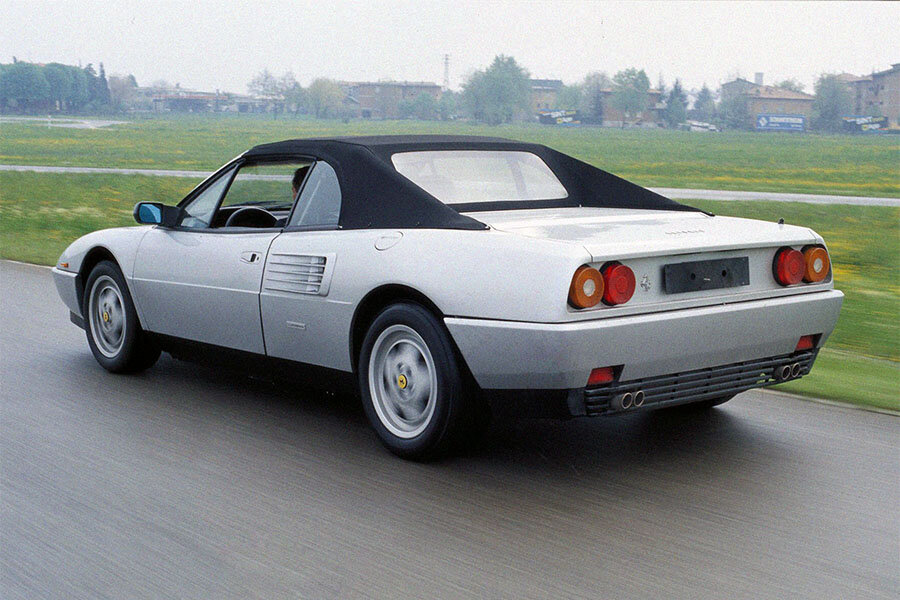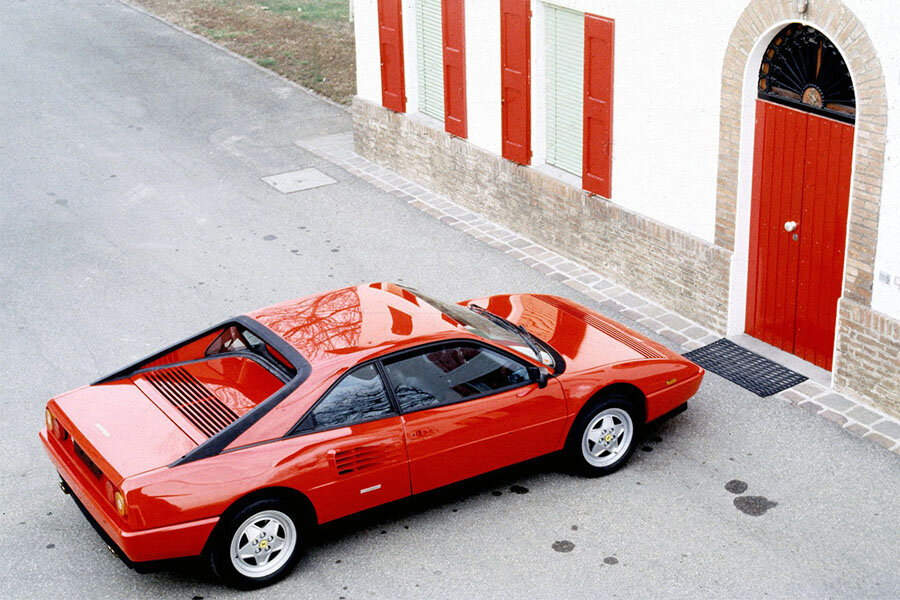Guide: Ferrari Mondial t - a Historical & Technical Appraisal
/BACKGROUND
During the 1950s, the pace of technical development in the automotive industry meant it was unusual for any Ferrari to remain in production for more than a couple of years.
However, by the early 1970s, a shift in manufacturing techniques and rising development costs meant most models stayed in production for much longer. Instead of wholesale changes, updates were phased in every couple of years to keep any given model ahead of the competition.
The 308 GTB / GTS and BB variants were a good illustration of this. Perhaps the ultimate example, though, was the 365 GT4 / 400 / 412 series which, by 1989, had reached its 17th year of production.
Another long-running model from this era was the Mondial which had originally been introduced during 1980 as a replacement for the 308 GT4.
Like the Lamborghini Urraco and Maserati Merak, the 308 GT4 and Mondial utilised a mid-engined layout with 2+2 seating. The concept for all these cars was to provide a practical entry level machine that could steal sales away from the Porsche 911.
In 1989, the Mondial underwent its fourth, final and most radical update: the Mondial t.
Although the model was coming towards the end of its life, Ferrari invested heavily in this final iteration. This was due to the fact that the big 412i had just been discontinued which meant, for the next few years, the Mondial t would be the firm’s only offering with more that two seats.
The ‘t’ was undoubtedly the most heavily revised Mondial of all. It notably featured a new layout for the power unit with the engine now mounted longitudinally while the gearbox was positioned transversely.
This change enabled Ferrari to mount the engine 13cm lower in the chassis which resulted in better weight distribution and improved handling.
Another significant update saw the engine enlarged from 3.2 to 3.4-litres. Power steering and electronically adjustable dampers were also added while a number of cosmetic changes freshened up the design.
The Mondial t was introduced at the Geneva Motor Show in March 1989. As before, it was offered in Coupe and Cabriolet body styles.
It joined a Ferrari line up that included the Flat 12-engined Testarossa and the limited production F40 which ran a twin turbocharged V8. The Mondial t was also sold alongside the 328 GTB / GTS for a few months until the 348 tb / ts arrived in September 1989.
CHASSIS
The Mondial's tubular steel chassis had originally been designed with a removable subframe that allowed the engine, gearbox and rear suspension to be dropped out as a single assembly. This meant the installation of a revised subframe to carry the engine and gearbox in their new positions was comparatively straightforward.
The revised chassis used by the Mondial t was given type number F108 AL/D for the Coupe and F108 AL/DN for the Cabriolet.
The wheelbase was unchanged at 2650mm.
Track was widened by 2mm at the front and 50mm at the rear.
Once again, suspension was fully independent. It comprised double wishbones and coil sprung telescopic shocks at each corner plus anti-roll bars at either end.
New gas-filled Bilstein dampers offered three alternative settings and could be adjusted via a toggle switch on the centre console. They replaced the conventional Koni shocks used on earlier Mondial derivatives.
Other new equipment included the aforementioned power steering which further enhanced the Mondial's refined character.
A larger fuel tank (increased from 80-litres to 96-litres) was located under the rear seats.
The brake system was imported from the outgoing Mondial 3.2. It featured ABS as standard with ventilated discs all round (282mm front / 280mm rear).
The same convex 16-inch Speedline wheels were also used. They measured 7-inches wide at the front, 8-inches wide at the back and originally came shod with either Michelin MXX or Goodyear Eagle tyres.
ENGINE / TRANSMISSION
Of all the normally aspirated V8-engined Ferrari road cars built since 1973, only the 308 GTB of 1975 to 1977 had been equipped with dry-sump lubrication. However, Ferrari returned to this racier arrangement for the Mondial t as well as the subsequent 348 which shared the same longitudinally mounted 3.4-litre engine.
Compared to earlier Mondial engines, the t’s new Tipo F119 DL power unit was uprated with Bosch Motronic M2.5 management which replaced the separate fuel-injection and ignition systems used previously.
An all-alloy construction was retained along with dual overhead camshafts per bank and four valves per cylinder.
Displacement rose from 3185cc to 3405cc thanks to an additional 2mm on both the bore and stroke (now 85mm and 75mm respectively).
The compression ratio was also increased from 9.8 to 10.4:1.
Peak output went from 270bhp at 7000rpm to 300bhp at 7200rpm and 224lb-ft at 5500rpm to 238lb-ft at 4200rpm.
The lower case 't' in the Mondial’s name reflected its unusual transversely mounted five-speed gearbox. Transmission was via a twin-plate clutch and limited-slip differential.
BODYWORK
Thanks to the cosmetic revamp carried out by Pininfarina for the Mondial 3.2 in 1985, only minor changes were deemed necessary for this latest variant.
The most obvious difference was the smaller, re-shaped engine intakes ducts carved out from the subtly re-profiled rear fenders.
Other changes included new body coloured door catches, a discreet Mondial t badge on the tail fascia and low profile pop-up headlights with single rectangular instead of twin circular lenses.
This limited programme of alterations were considered sufficient to see the model through its last few years in production.
As per the Mondial 3.2, body panels were predominantly steel with fibreglass used for just the bumpers.
In order to accommodate a folding canvas soft top, the rear seats in the Mondial Cabriolet were smaller than in the Coupe. For the same reason, the Cabriolet also came with a smaller fuel tank (86-litres instead of 96-litres).
INTERIOR
Inside, significant changes were made as the cockpit was given a major facelift.
New equipment included a re-shaped instrument binnacle and vertical control panel that linked the dash and centre console.
Large gauges for road and engine speed were split by smaller read outs for water temperature and oil pressure stacked one above the other. More small read outs for fuel and oil temperature were located in each corner.
Two separate groups of modern new switches were located on the centre console and transmission tunnel.
The front and rear seats were completely redesigned. Those in the back now folded down to provide an additional luggage platform. To accommodate this feature, the rear armrest seen on earlier Mondials was deleted.
Elsewhere, redesigned grab panels on the doors now housed the electric window switches (which were moved from the centre console).
The Mondial had always been equipped to a very high specification and this latest example was no different. Standard equipment included leather upholstery, air-conditioning, tinted glass, electric windows and electric mirrors. Audio equipment was normally installed by the supplying dealer.
OPTIONS
A small number of optional extras were available. They included metallic paint, Schedoni luggage and leather upholstery for the dash and headliner.
Additionally, Coupe buyers could specify an electric sunroof while those ordering the Cabriolet could choose a leather instead of canvas tonneau to cover the hood when lowered.
WEIGHT / PERFORMANCE
Ferrari quoted a weight of 1426kg for the Coupe and 1468kg for the Cabriolet (up 16kg and 68kg respectively).
Top speed went from 155mph to 158mph while the 0-62mph time dropped from 6.5 to 6.3 seconds.
USA VERSION
Although Ferrari were edging ever closer to producing a true world market car, there were still some differences between US-spec. examples and those bound for most other markets.
The Tipo F119 G engine used for the US variant featured a special exhaust system with twin silencers and separate catalytic converters for each bank of cylinders. Peak power was 5bhp lower at 295bhp.
USA specification derivatives were easily identifiable on account of their large rectangular side lights attached to each fender.
PRODUCTION CHANGES
Few modifications were made after the Mondial t was launched at Geneva in March 1989.
In 1990, the engine management system was upgraded to Bosch M2.7 and catalytic converters were added to all cars. Peak power dropped to 295bhp as a result.
Towards the end of production, a Valeo manually-operated clutch-less gearbox was added to the options list. This innovative system used an electronic clutch that was actuated as soon as the gear lever was moved. It worked extremely well, but was dropped in favour of the F1-style paddle-shift arrangement adopted on the F355 from 1997.
Less than ten Valeo-equipped cars are understood to have been built.
END OF PRODUCTION
Ferrari stopped building the Mondial t in late 1993.
By this time, 840 Coupes had been completed (45 in right-hand drive). There were also 1017 Cabriolets (51 of which were right-hand drive).
The Mondial was not replaced as Ferrari decided to abandon the mid-engined 2+2 concept.
In total, over 6000 Mondials had been built since the model arrived in 1980.
Ferrari did eventually revisit the idea of a junior 2+2 with the front-engined California of 2008.
Text copyright: Supercar Nostalgia
Photo copyright: Ferrari - https://www.ferrari.com



































